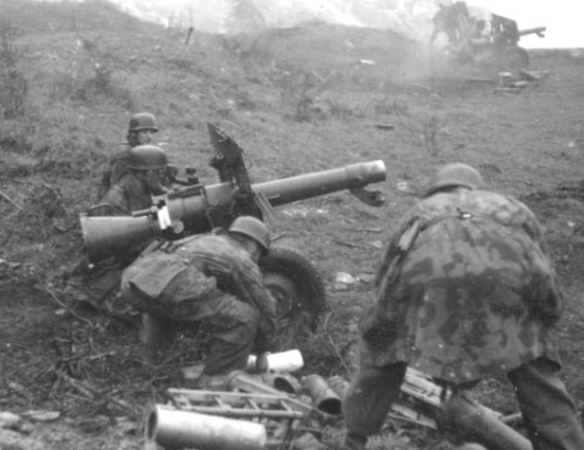10.5cm LG 40 (Olpe)
This was a Krupp design originally known as the LG 2/Kp to distinguish it from the contemporary development-the LG 2/Rh-being done by Rheinmetall-Borsig.
A defect in the original 75mm LG design that became apparent after some use, as outlined above, was that the rapid erosion by the gas blast through the venturi of the firing mechanism housing; the mechanism itself became clogged with fouling. To cure this, a new type of cartridge case was developed in which the primer was inserted at the side of the case and where a `bandolier’ igniter surrounded the bottom of the propellant charge to ensure even ignition. This, of course, demanded precise breech location of the cartridge so that the primer cap lay under the firing pin, and this was done by making a wedge-shaped surround for the primer housing which engaged in a matching recess in the chamber wall. The firing mechanism was mounted on top of the breech-ring.
A second defect revealed itself in action: after about 300 rounds had been fired, the mountings began to disintegrate. This was partly due to erosion of the jets, leading to out-of-balance forces, but principally owing to the torque imparted to the gun structure as the projectile engaged in the rifling. So the recoilless principle was extended in a radial direction by welding curved vanes inside the jet nozzle that were curved in the opposite direction to the rifling; these then instigated an opposite torque in the jet and thus balanced the turning moment acting on the carriage.
The LG 40 was more or less an enlarged version of the Krupp 7.5cm model, with the same side-swinging breech and large pneumatic-tyred wheels. A short box trail was fitted, simply as a support, and a shield also appeared. The whole equipment could be dismantled into five parachute loads, each in a container: barrel, breech, carriage body, axle and trail, and wheels. Each container held, in addition to the gun parts, four rounds of ammunition plus a rifle and small-arms ammunition for the detachment. The LG 40 could also be dropped in the assembled condition, packed in a special shock-absorbing crate.
The original version had the mounting made of aluminium/magnesium alloy, but when this material became scarce a new pattern in welded steel was issued. Guns with the light alloy mountings were then known as L G 40-1 and those with the steel mounting as LG 40-2.
Data
Calibre: 105mm/4.13in.
Length of gun: 1902mm/74.88in.
Length of bore: 1380mm/54.33in.
Rifling: 32 grooves, right-hand increasing twist, 1/17.25 to 1/11.75.
Breech mechanism: side opening, percussion fired.
Traverse: 80°.
Elevation: −15° to +40° 30′.
Weight in action: 388kg/856lb.
Performance
Firing standard high explosive shell weighing 14.80kg(32.63lb).
Standard charge: velocity 335mps/1099fps, maximum range
7950m/8695yd.
Ammunition
Separate-loading, cased charge.
Projectiles
10.5cm F H Gr 41: fuzed AZ 23v(0.15) or Dopp Z S/60, weight
14.80kg(32.63lb).
In spite of the changed number, examinations of specimens and drawings reveal this shell to be the same as the 10.5cm F H Gr 38 used with the le FH 18 howitzer. A bimetallic (KPS) driving band was fitted and the filling was 1.38kg (3.04lb) of poured TNT.
10.5cm Gr 39 H1/B: fuzed AZ 38, weight 12.25kg (27.01lb).
This was also the shell used with the le F H 18. When fired from the LG 40, owing to its lesser weight, it developed a muzzle velocity of 373mps (1224fps) and a maximum engagement range of 1500m(1640yd) was stipulated.
Propelling Charges
This was a single charge consisting of 3.09kg (6.81lb) of Gudol R P with a bandolier igniter of NZ Man P wrapped around the lower end of the sticks.
Primer
The percussion primer C/13nA St was standard.
